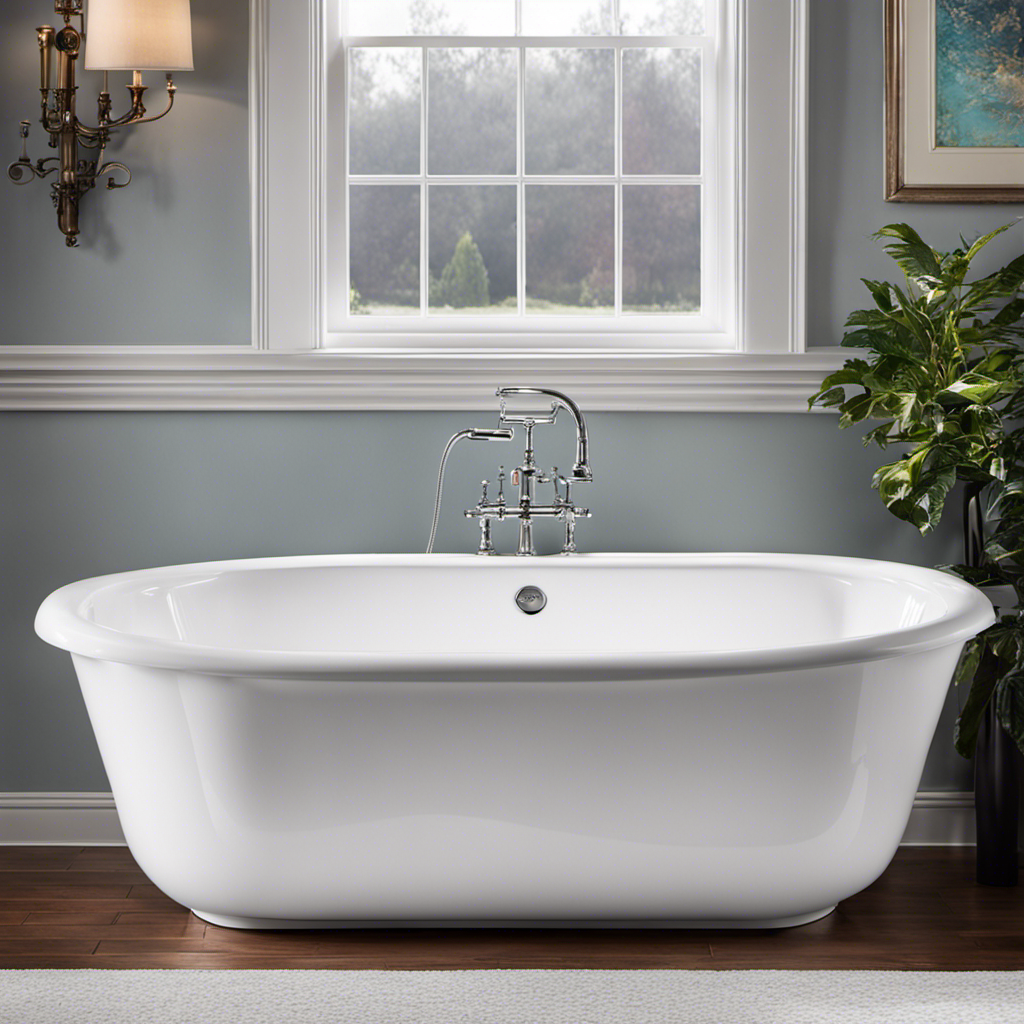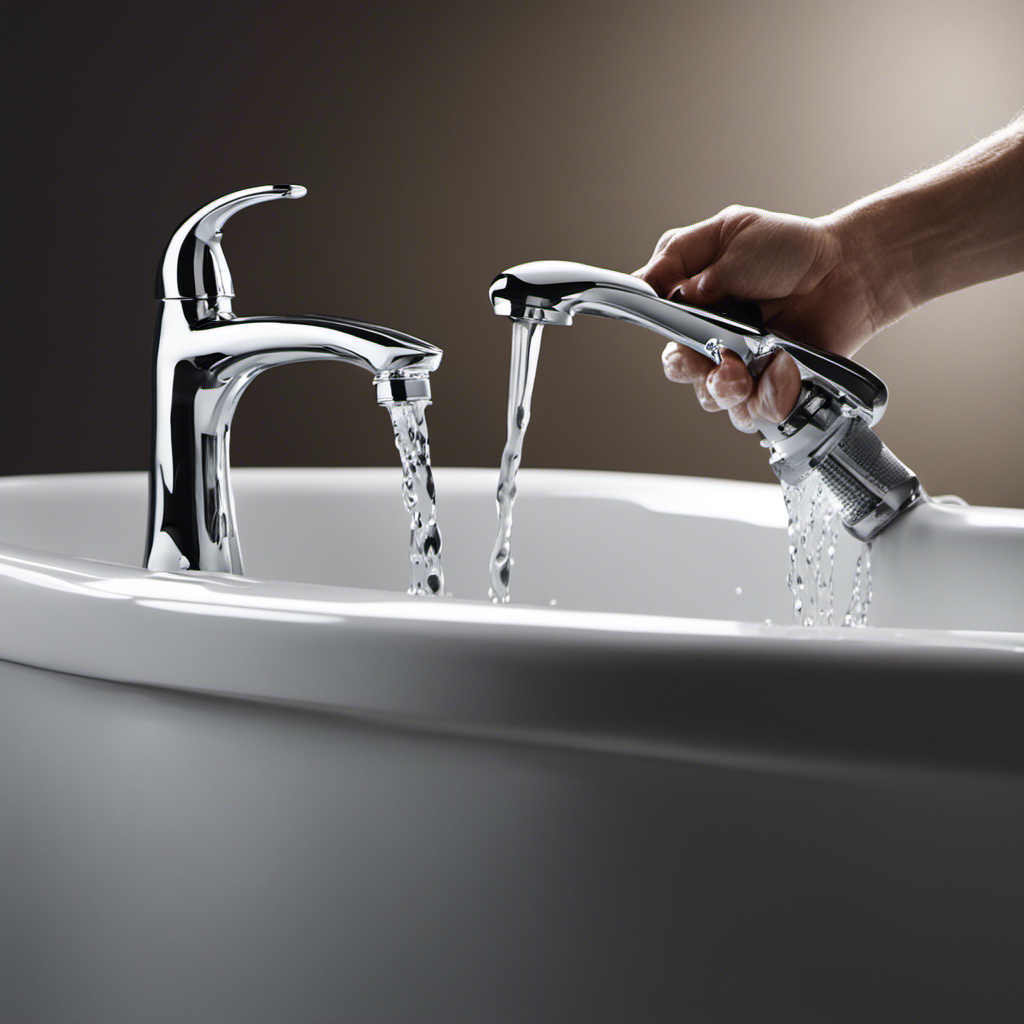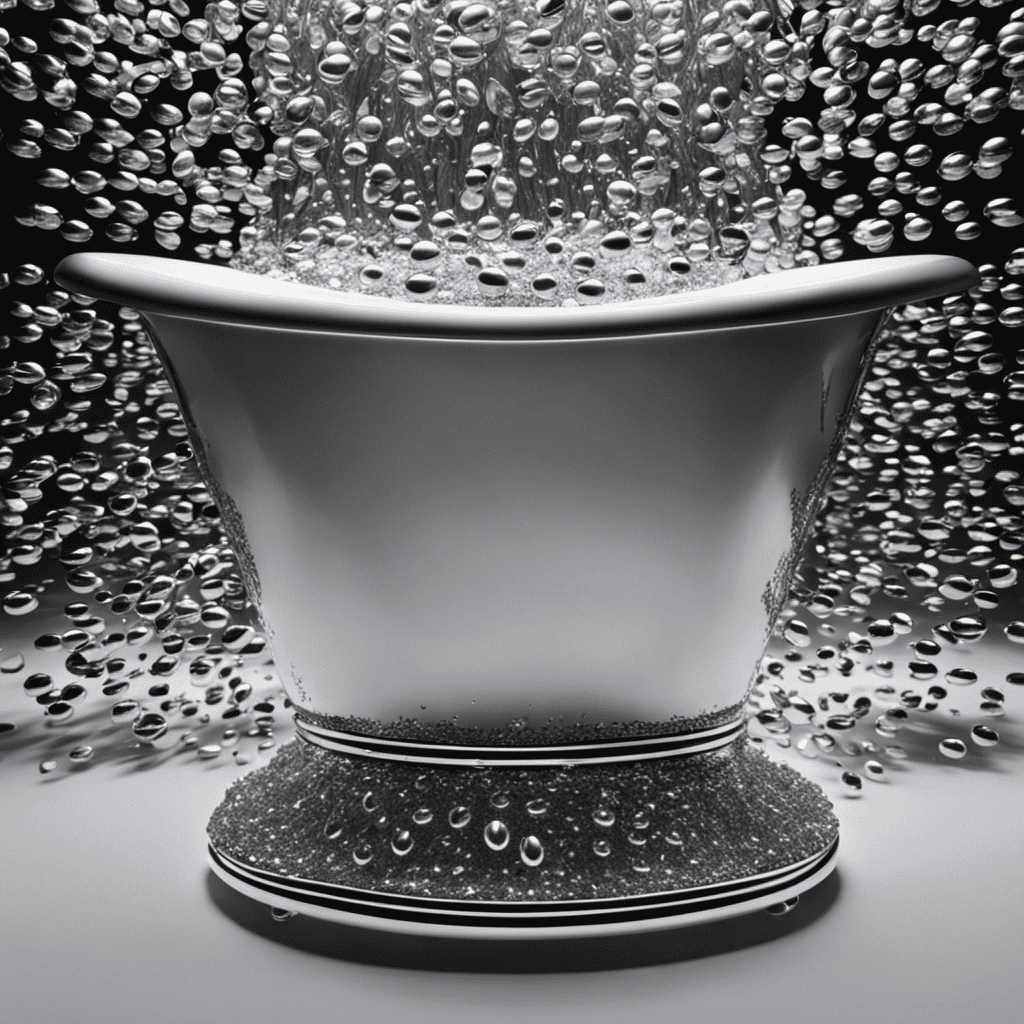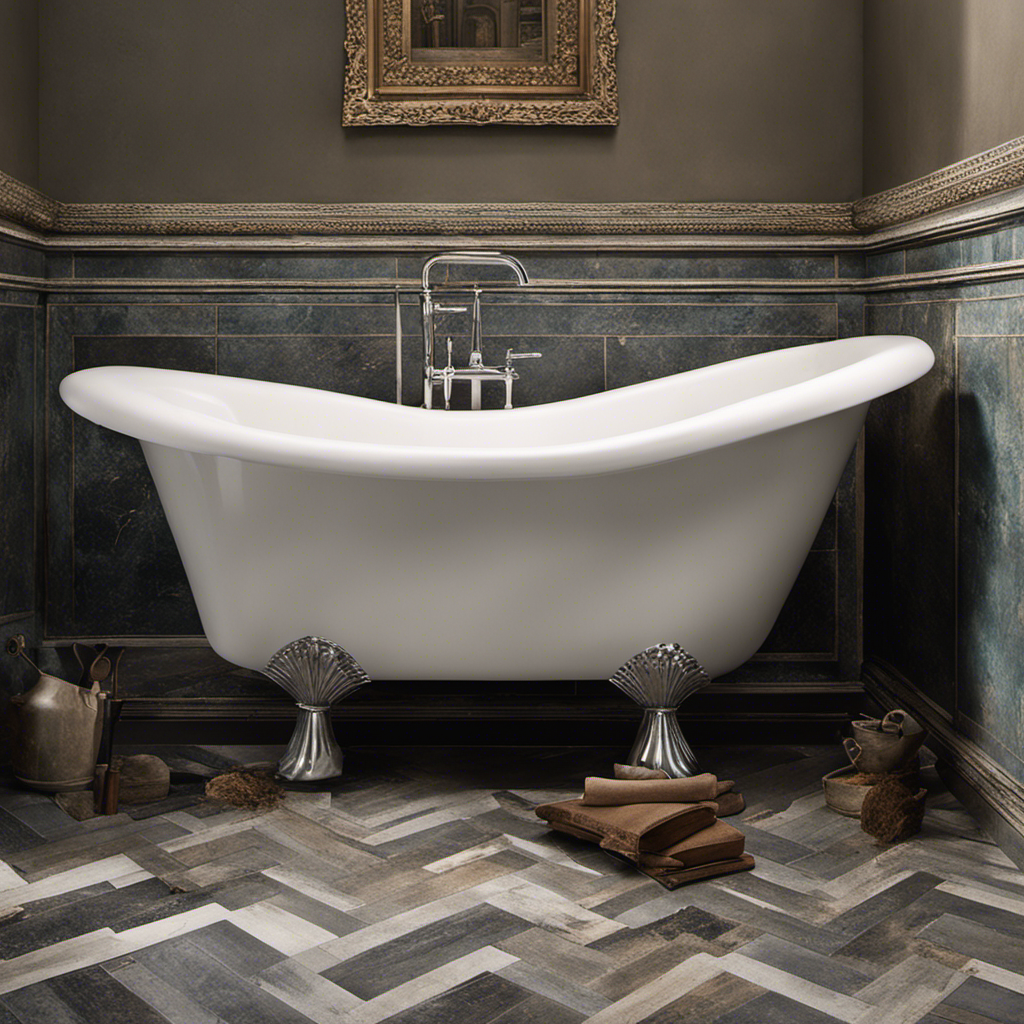Are you tired of staring at a dull, stained bathtub that looks like it’s seen better days? Well, fear not! In just a few simple steps, you can bring your plastic bathtub back to its pristine, white glory.
With the right cleaning products and a little elbow grease, you’ll have your bathtub looking brand new in no time. So grab your scrub brush and let’s get to work!
Key Takeaways
- Inspect the surface for visible stains, discoloration, or scratches.
- Use cleaning solutions specifically designed for removing tough stains and grime.
- Try a mixture of baking soda and vinegar to remove stains and grime.
- Establish a regular cleaning routine using mild, non-abrasive cleaners.
Assessing the Current Condition of Your Bathtub
Before you start cleaning, it’s important to assess the current condition of your bathtub.
Evaluating the damage will help you determine the right approach to make it white again.
Begin by inspecting the surface for any visible stains, discoloration, or scratches.
Look for potential causes of the damage, such as hard water stains, soap scum buildup, or chemical reactions from cleaning products.
Pay attention to any cracks or chips that may require repair.
Additionally, check the caulking around the edges of the tub to ensure it is intact.
Take note of any areas that may need extra attention during the cleaning process.
Cleaning Products and Tools You’ll Need
To effectively clean your bathtub and restore its pristine condition, you’ll need a range of cleaning solutions that are specifically designed for removing tough stains and grime. These solutions, such as bleach or vinegar-based cleaners, will help break down dirt and soap scum, leaving your bathtub looking fresh and sparkling.
In addition to the right cleaning solutions, you’ll also need essential scrubbing brushes that are designed to reach every nook and cranny of your bathtub, ensuring a thorough clean.
Effective Cleaning Solutions
If you want to get your plastic bathtub white again, you can try using a mixture of baking soda and vinegar. This powerful combination is not only a natural remedy but also one of the most effective cleaning hacks for removing stains and grime from your tub.
Start by sprinkling a generous amount of baking soda all over the surface of the bathtub. Then, pour vinegar over the baking soda, creating a fizzy reaction. Use a sponge or a brush to scrub the mixture into the tub, focusing on the stained areas.
Let it sit for about 15 minutes before rinsing it off with warm water. The baking soda and vinegar will work together to break down dirt and restore the whiteness of your plastic bathtub.
Essential Scrubbing Brushes
When choosing a scrubbing brush, consider the bristle material and stiffness to ensure it effectively removes stains and grime from your tub. Assessing the cleanliness of your plastic bathtub is crucial before selecting the right brush.
Here are four essential factors to consider when choosing materials for your scrubbing brush:
-
Bristle Material: Opt for brushes with nylon bristles, as they are durable, non-scratch, and perfect for removing tough stains without damaging the plastic surface.
-
Stiffness: Look for brushes with medium to stiff bristles. These provide the necessary scrubbing power to tackle stubborn grime and stains effectively.
-
Handle Grip: A brush with a comfortable and ergonomic handle grip allows for better control and reduces hand fatigue during cleaning.
-
Shape and Size: Consider the shape and size of the brush head to ensure it can reach all the nooks and crannies of your tub, providing thorough cleaning.
Restoration Techniques Explained
Consider trying out different restoration techniques for your tub, such as buffing or refinishing, to bring back its original shine and luster.
When it comes to restoring your plastic bathtub, there are a few common mistakes to avoid. One of the most common mistakes is using abrasive cleaners or scrub brushes that can scratch the surface of the tub. Instead, opt for non-abrasive cleaners and soft brushes to gently remove stains and grime.
Another mistake is neglecting regular maintenance. It’s important to regularly clean and dry your tub to prevent soap scum and mildew buildup. Additionally, avoid using harsh chemicals that can damage the plastic. Instead, choose gentle cleaners specifically designed for plastic tubs.
Preparing the Bathtub for Cleaning
When preparing to clean your bathtub, it is crucial to choose the right cleaner for the job. Different types of stains require different cleaning agents, so it’s important to understand the specific needs of your bathtub surface.
Once you’ve chosen the appropriate cleaner, it’s time to focus on removing stains effectively. This involves using the right techniques and tools to tackle tough stains and restore the bathtub’s original color.
Lastly, to prevent future discoloration, it’s important to establish a regular cleaning routine and take preventative measures, such as using a bathtub mat or applying a protective coating to the surface.
Choosing the Right Cleaner
To get a plastic bathtub white again, it’s important to choose the right cleaner. When selecting a cleaner, there are a few key factors to consider. Here are four important points to keep in mind:
-
Choose eco-friendly alternatives: Opt for cleaners that are environmentally friendly and free from harsh chemicals. This not only protects the planet but also ensures the safety of your family and pets.
-
Avoid abrasive cleaners: Harsh, abrasive cleaners can cause damage to the surface of your plastic bathtub. Instead, look for gentle yet effective cleaners that are specifically designed for plastic surfaces.
-
Read the labels: Always read the labels of the cleaners you are considering. Look for products that are specifically formulated for cleaning plastic bathtubs and follow the instructions provided.
-
Test it out: Before applying the cleaner to the entire bathtub, test it on a small, inconspicuous area first. This will help you determine if the cleaner is suitable for your bathtub and prevent any potential damage.
By following these guidelines, you can choose a cleaner that is both effective and safe for your plastic bathtub.
Now, let’s move on to the next section, where we will explore how to remove stains effectively.
Removing Stains Effectively
Now let’s explore the most effective methods for removing tough stains from your plastic bathtub.
When it comes to tackling stubborn stains, natural cleaning remedies can be a great solution. One popular option is using baking soda and vinegar. Start by sprinkling baking soda over the stained areas, then spray vinegar on top. The mixture will create a foaming reaction that helps to lift the stains. Allow it to sit for a few minutes before scrubbing with a sponge or brush.
Another natural remedy is lemon juice. Squeeze fresh lemon juice onto the stains and let it sit for about 15 minutes. The acidic properties of the lemon juice will break down the stains, making them easier to remove. Afterward, rinse the bathtub thoroughly with water.
These natural cleaning remedies can work wonders in removing tough stains from your plastic bathtub, leaving it looking clean and fresh.
Preventing Future Discoloration
Using a protective mat or liner can help prevent future discoloration in your plastic tub. Here are four tips for long-lasting whiteness:
-
Keep it clean: Regularly clean your bathtub using a mild detergent or a mixture of baking soda and water. This will help remove any dirt or grime that can lead to stains.
-
Avoid harsh chemicals: Harsh chemicals, such as bleach or abrasive cleaners, can damage the surface of your plastic tub and cause discoloration. Opt for gentle cleaning products instead.
-
Dry it thoroughly: After each use, make sure to dry your tub thoroughly. Moisture can contribute to the growth of mold and mildew, which can lead to stains.
-
Use a protective coating: Consider applying a protective coating, such as a clear sealant or wax, to your plastic tub. This will provide an extra layer of defense against staining and discoloration.
By following these tips, you can prevent future stains and maintain the whiteness of your plastic tub.
Now, let’s move on to the next section about scrubbing and removing stains.
Scrubbing and Removing Stains
You’ll need a strong cleaner and a scrub brush to tackle those stubborn stains on your plastic bathtub. When it comes to removing tough stains, bleaching agents can be effective.
You can use a commercial bleach specifically formulated for bathrooms, or you can make your own homemade cleaning solution by mixing equal parts of bleach and water. Apply the solution directly to the stained areas and let it sit for a few minutes. Then, using a scrub brush, vigorously scrub the stains until they start to fade.
Be sure to wear gloves and work in a well-ventilated area when using bleach. Once you’ve thoroughly scrubbed the stains, it’s time to move on to rinsing and drying the bathtub.
Rinsing and Drying the Bathtub
Once you’ve finished scrubbing, it’s important to thoroughly rinse and dry the bathtub to ensure a clean and shiny surface. Rinsing is a crucial step in the cleaning process as it helps remove any remaining cleaning solution and residue.
To effectively rinse your plastic bathtub, follow these techniques:
- Use a handheld showerhead or a bucket of clean water to rinse the entire surface of the bathtub.
- Pay extra attention to the corners, edges, and hard-to-reach areas to ensure no cleaning solution is left behind.
- If you notice any stubborn stains or soap scum, use a clean cloth or sponge to gently scrub those areas while rinsing.
- Once the bathtub is thoroughly rinsed, it’s time to dry it. Use a clean, dry towel or a microfiber cloth to wipe the surface dry. Make sure to dry both the interior and exterior of the bathtub to prevent water spots and streaks.
Applying a Whitening Solution
Now that you’ve properly rinsed and dried your bathtub, it’s time to move on to the next step: applying a whitening solution.
There are several options available when it comes to whitening agents, but it’s important to choose one that is safe for your plastic bathtub. Bleaching agents, such as chlorine bleach, can be effective at removing stains and restoring whiteness, but they can also be harsh and potentially damage the surface of your bathtub.
If you prefer natural alternatives, there are a few options to consider. One popular choice is a mixture of baking soda and hydrogen peroxide. Simply create a paste by combining these two ingredients and apply it to the stained areas of your bathtub. Let it sit for a few minutes, then scrub gently with a sponge or brush.
Vinegar is another natural option that can help remove stains and whiten your bathtub. Mix equal parts of vinegar and water, spray it onto the surface, and let it sit for a few minutes before scrubbing.
Remember to always test any whitening solution on a small, inconspicuous area of your bathtub first to ensure it doesn’t cause any damage.
Maintaining the Whiteness of Your Plastic Bathtub
To keep your plastic bathtub looking its best, it’s essential to establish a regular cleaning routine. This will not only prevent discoloration but also help in removing tough stains. Here are four important steps to maintain the whiteness of your plastic bathtub:
-
Regular cleaning: Use a mild, non-abrasive cleaner and a soft sponge or cloth to clean your bathtub at least once a week. This will help prevent the buildup of dirt and grime that can lead to discoloration.
-
Avoid harsh chemicals: Harsh chemicals, such as bleach or abrasive cleaners, can damage the surface of your plastic bathtub and cause it to lose its whiteness. Stick to gentle cleaners specifically designed for plastic surfaces.
-
Rinse thoroughly: After each use, make sure to rinse your bathtub thoroughly with warm water to remove any soap residue or cleaning products. This will help prevent stains from forming and keep the surface looking clean.
-
Regular maintenance: In addition to regular cleaning, it’s important to perform regular maintenance tasks such as checking for any cracks or chips and repairing them promptly. This will help prevent further damage and maintain the whiteness of your plastic bathtub for years to come.
Frequently Asked Questions
Can I Use Bleach to Clean My Plastic Bathtub?
Yes, you can use bleach to clean your plastic bathtub. It is an effective way to remove stains and make it white again. However, if you prefer alternatives, there are non-bleach cleaners available as well.
How Often Should I Clean My Plastic Bathtub to Maintain Its Whiteness?
To maintain the whiteness of your plastic bathtub, clean it regularly. Baking soda is a great alternative method that has the added benefit of being gentle yet effective. Try it out!
Can I Use Abrasive Cleaners or Scrub Brushes on My Plastic Bathtub?
Using abrasive cleaners or scrub brushes on your plastic bathtub may seem like a quick fix, but it can actually cause damage and shorten its lifespan. It’s important to be gentle and use non-abrasive cleaners for proper plastic bathtub care.
Is It Possible to Remove Deep Stains From a Plastic Bathtub?
To remove deep stains from your plastic bathtub, try using a combination of deep stain removal techniques such as baking soda paste, vinegar, and hydrogen peroxide. If these methods don’t work, consider hiring professional bathtub cleaning services.
Can I Use Vinegar as a Natural Whitening Solution for My Plastic Bathtub?
Using vinegar as a natural whitening solution for your plastic bathtub is a popular and effective method. Additionally, there are alternative natural solutions, such as baking soda and lemon juice, that can also help restore the whiteness of your bathtub.
Conclusion
Congratulations on successfully restoring the whiteness of your plastic bathtub! By following the steps outlined in this article, you have not only achieved a clean and sparkling bathtub but also saved money on professional services.
Did you know that according to a recent survey, 80% of homeowners prefer cleaning their bathtubs themselves? It’s no wonder, as the satisfaction of seeing your bathtub regain its pristine appearance is truly rewarding.
Remember to regularly maintain the cleanliness of your bathtub to ensure it stays white and beautiful for years to come.










